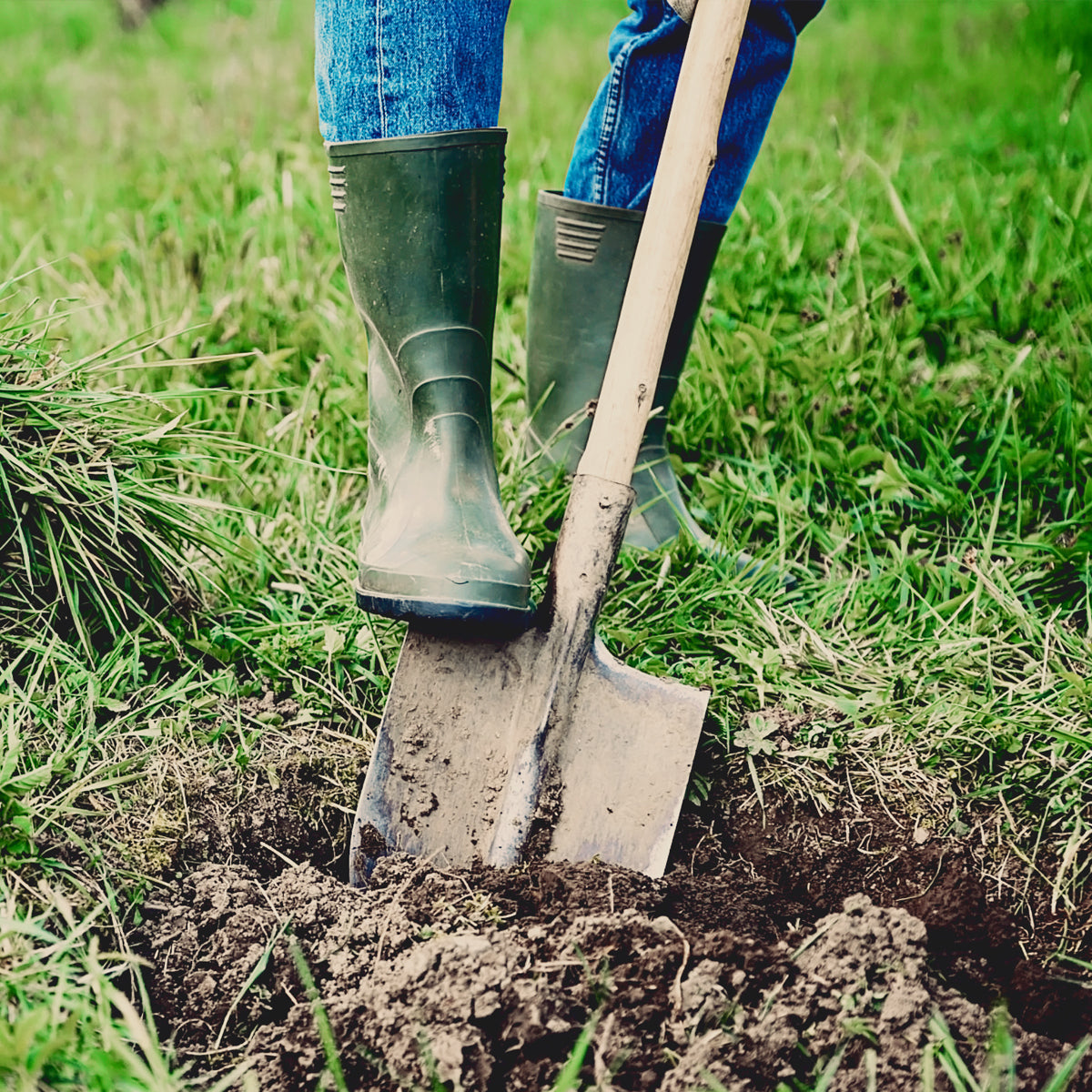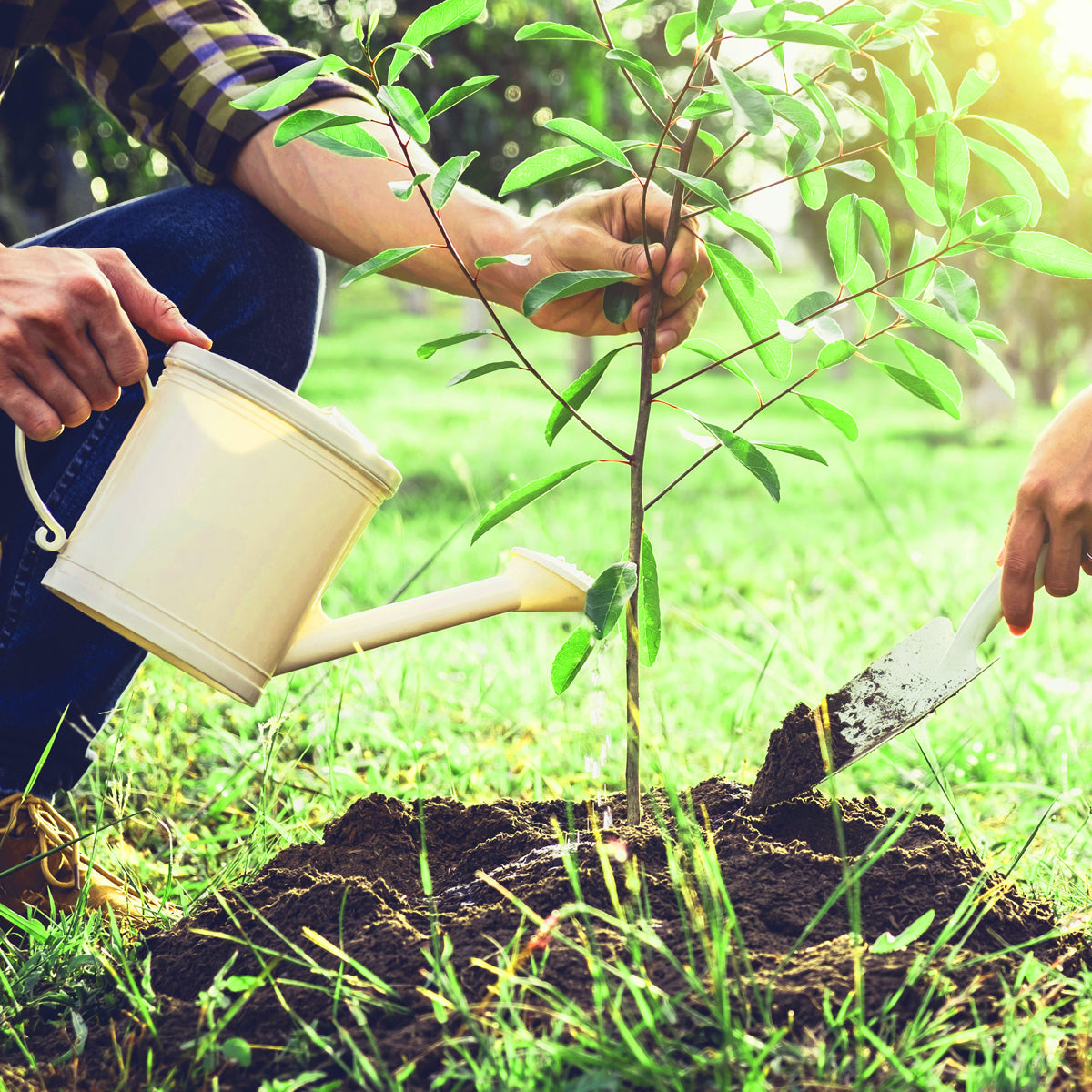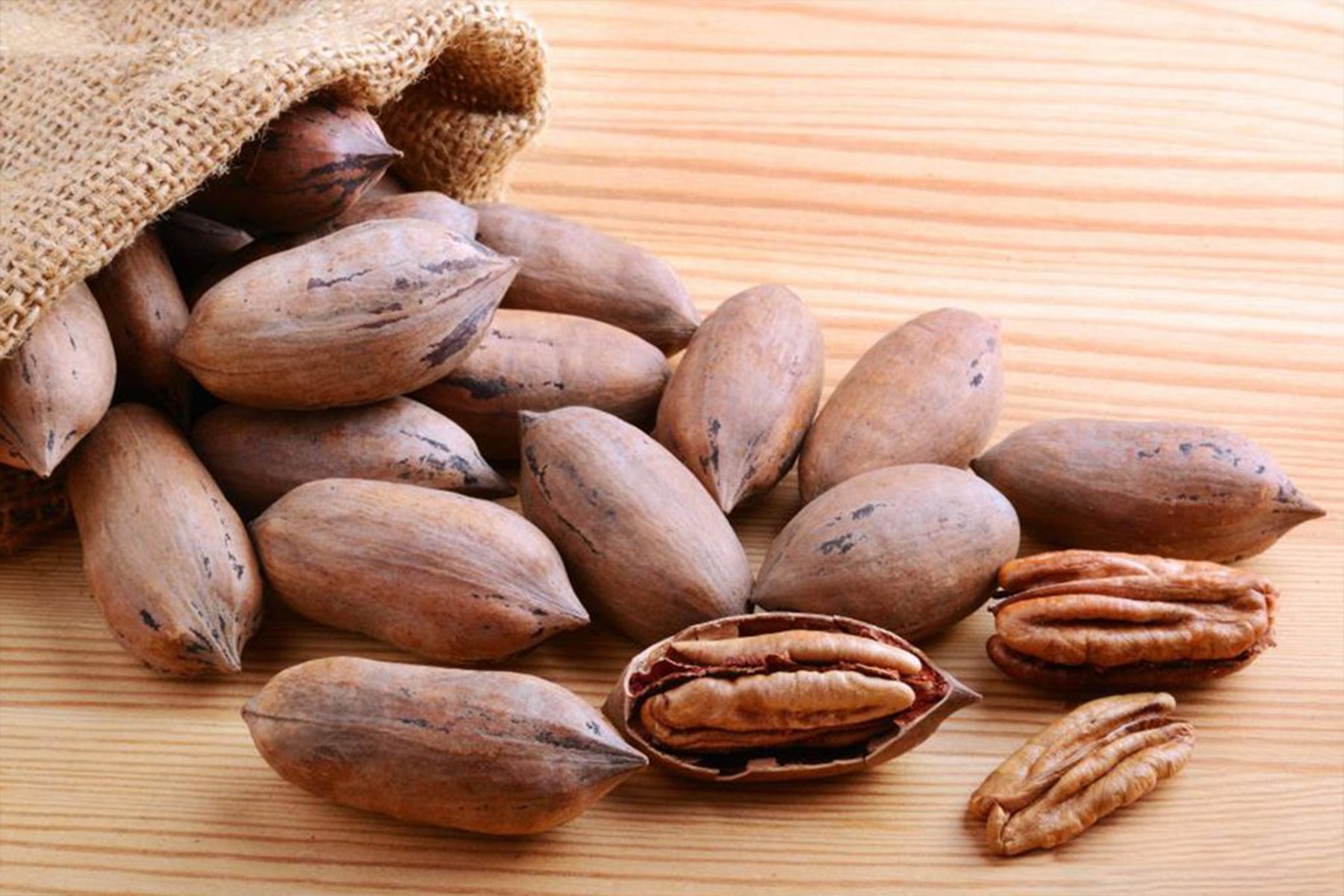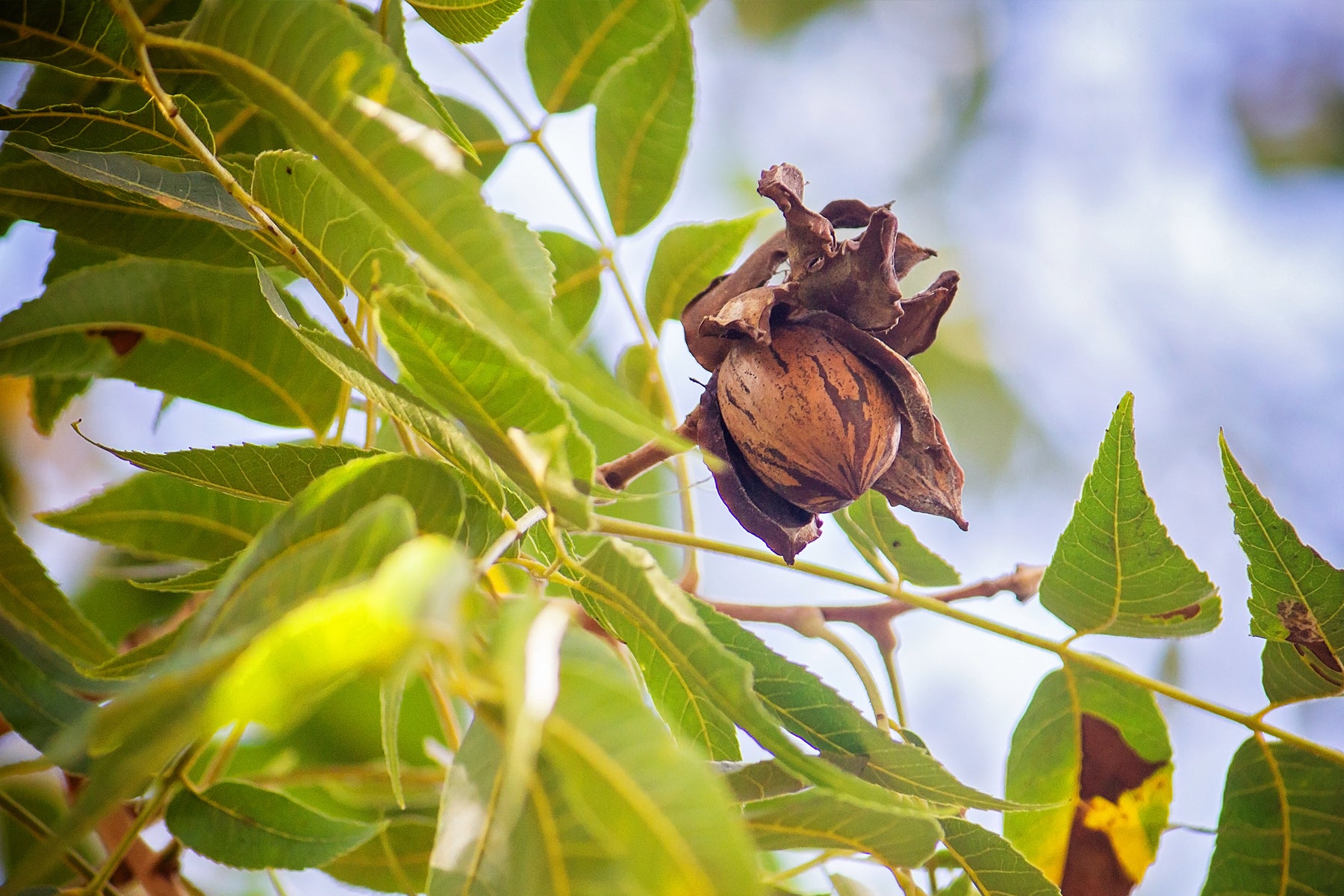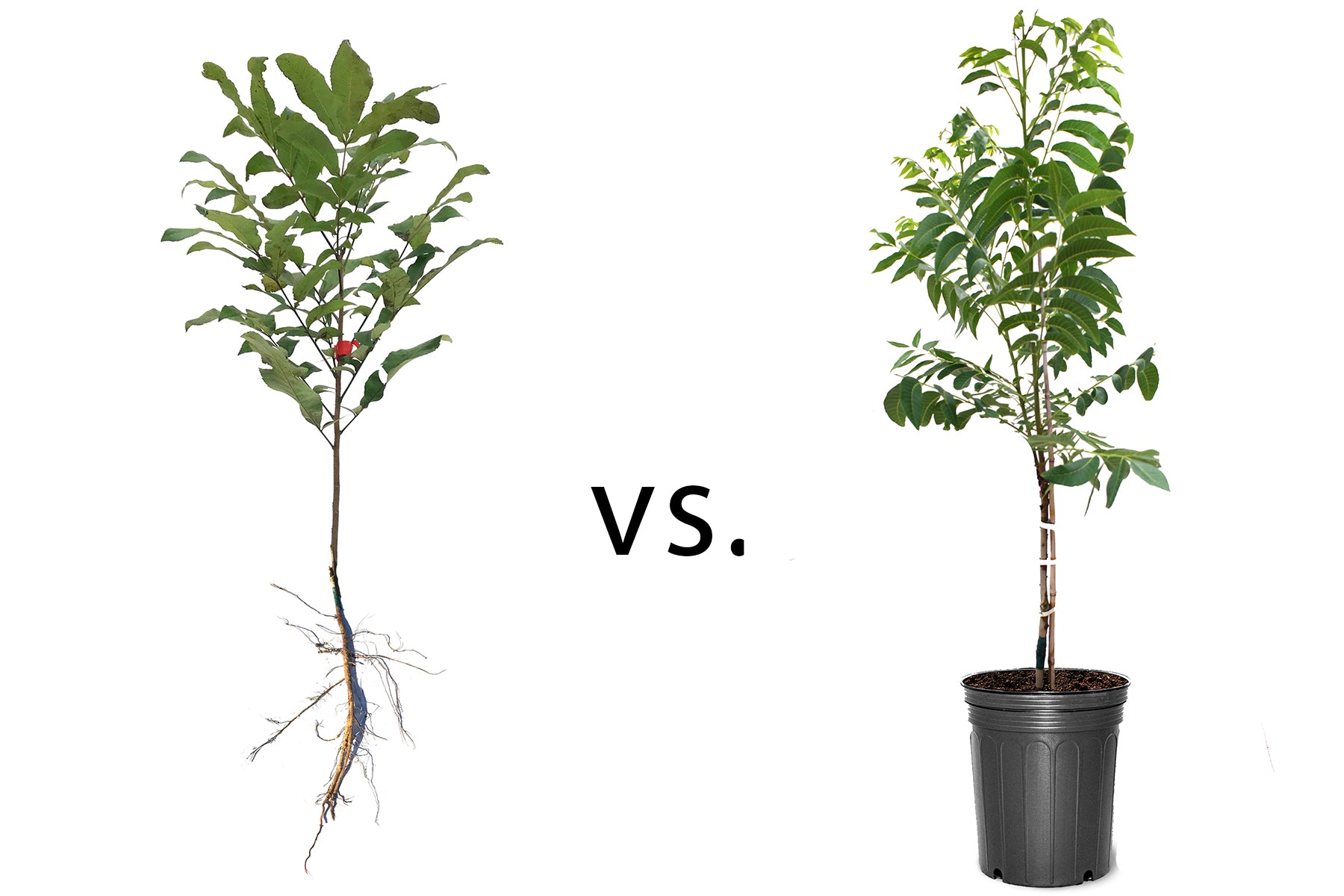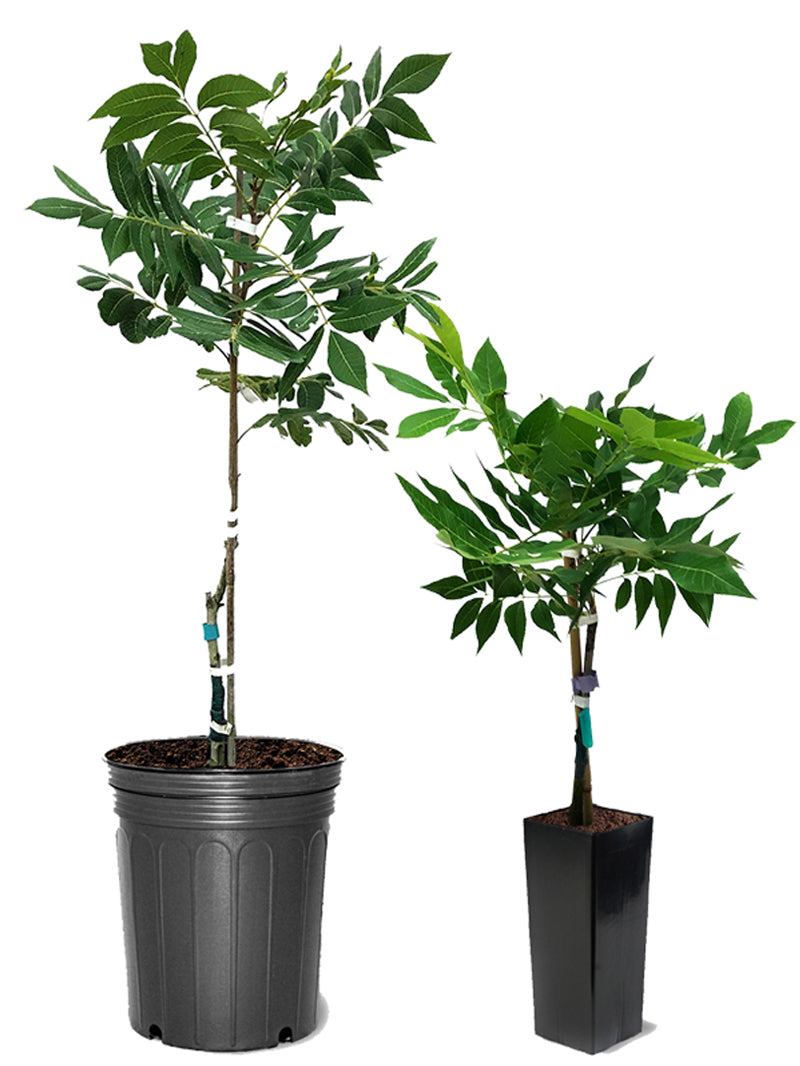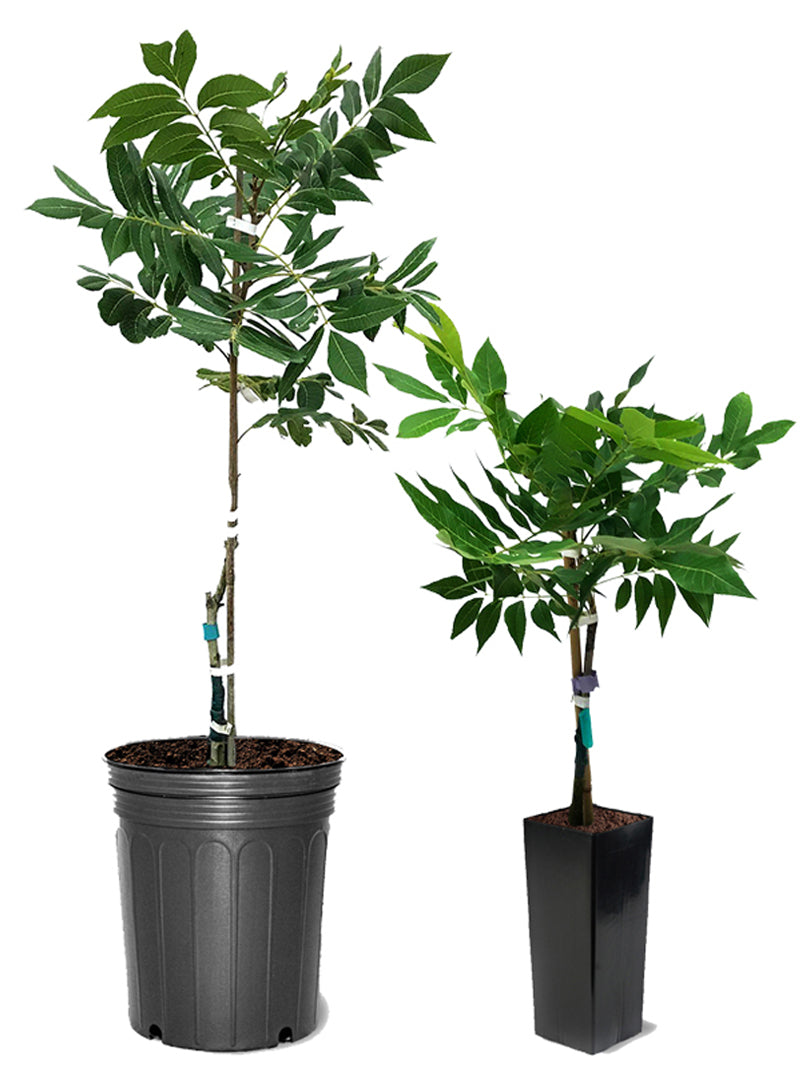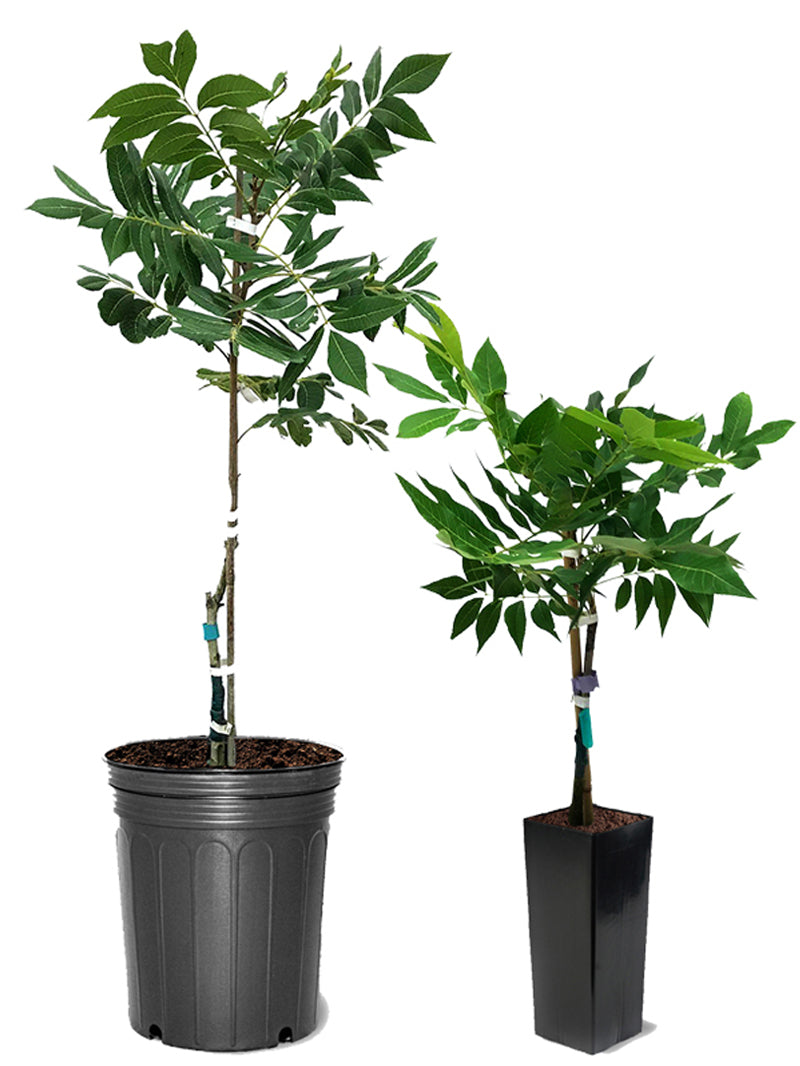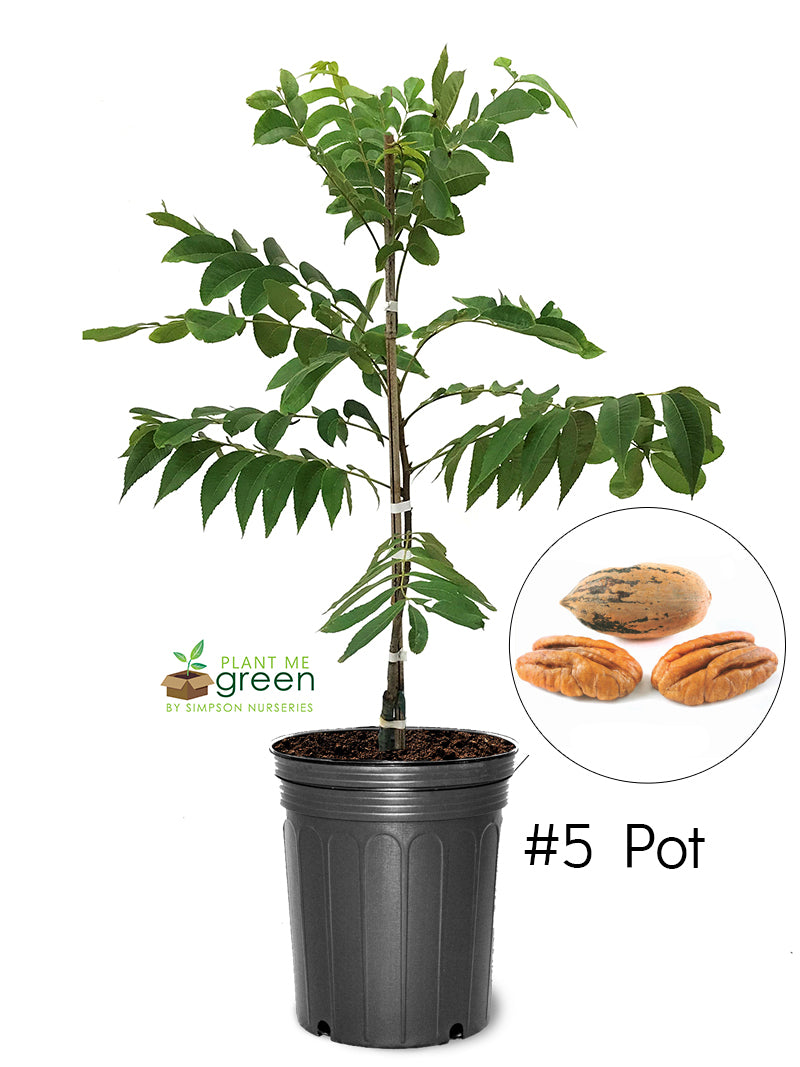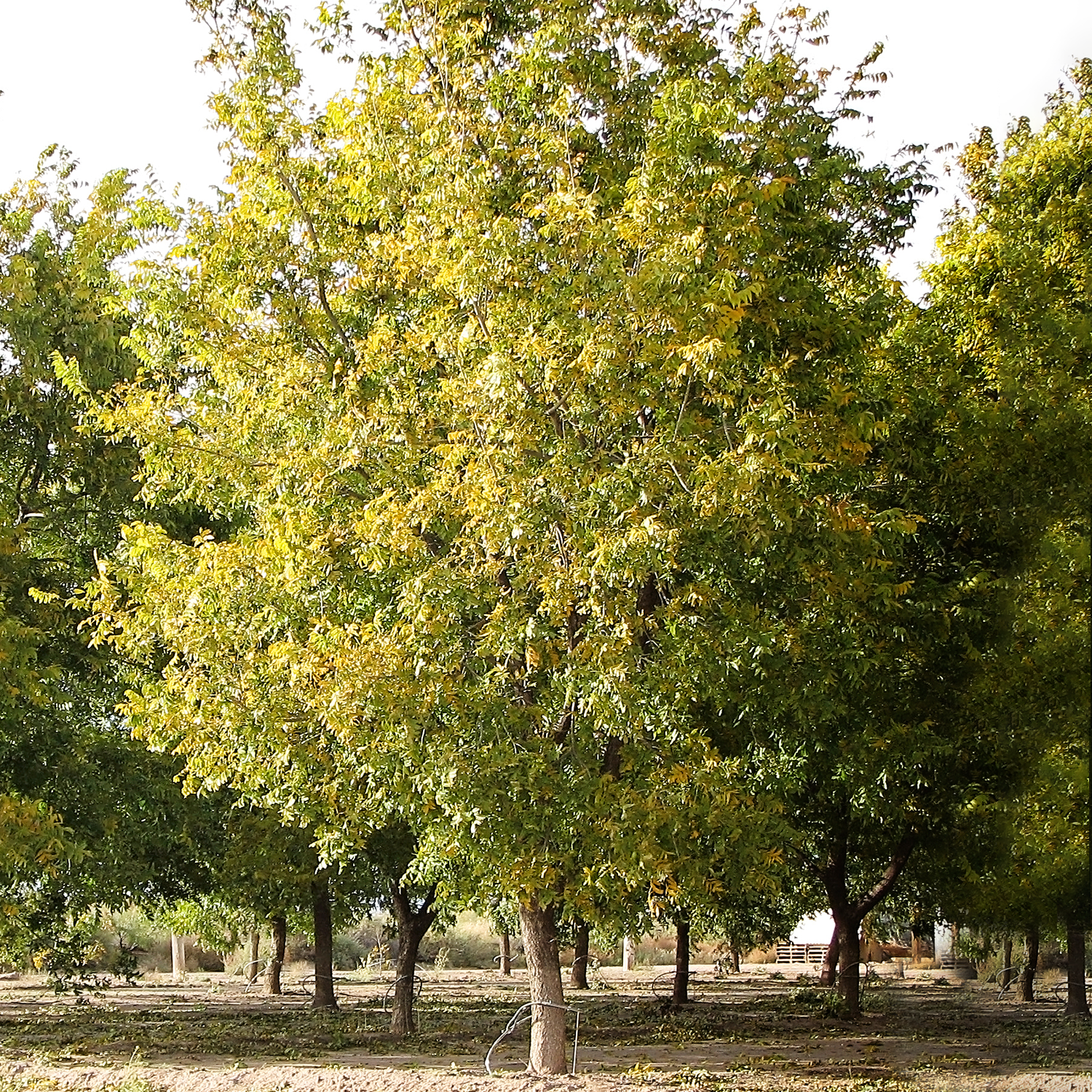
Planning your Pecan Tree site
The most important factors to consider in choosing a site for planting pecan trees are: soil type, depth, and drainage. Pecans will grow in almost any soil in southern states, except poorly drained soil, hardpan or stiff clays, or thin sands with a high water table. It is most important that the soil should have good water holding capacity. For proper root penetration, it should be several feet deep.
In selecting a planting site, keep in mind the desirable soil characteristics described above. Avoid badly eroded hills. If not eroded, hilltops and north, east, south, or west slopes are satisfactory. In most cases, even bottom land along streams has proved a good location if well drained. The greater movement of the air often causes faster drying of morning dews and rains which help prevent scab infection.
And finally, select a planting site away from buildings and power lines. Always consider the mature size of pecan trees when deciding on a planting site. If planting more than one pecan tree, space at least 40-60 feet apart so they have adequate space to grow.
Soil Prep for Your Pecan Tree
It’s time to start digging! First, you will need to dig a hole three times the width of the size of the pot, and just as deep as the root ball. Plant the tree level with where it grew in the nursery (i.e. the soil line, which is indicated by a color change on the bark) but not too deep. Fill the hole about ⅓ full of topsoil and saturate the soil with water to settle, repeating this operation until the hole is almost full. Most recommendations are to raise the pH of acidic soil for zinc to be taken up through the foliage. Pecans like a pH range of 6.5 to 7. Have a soil test done to determine the pH level of the soil, and if the soil is below 5.6 add dolomitic limestone to your soil as the hole is being filled to raise the pH. Once the hole is filled, construct a water basin around the tree 3 or 4 feet in diameter and 6 to 8 inches deep.
Soils for planting pecan trees may be red, brown, or gray in color, but it is necessary they contain sand or sandy-loam and that the subsoil be of clay or semi-clay structure. During the first growing season, water the trees once a week on clay soils and twice a week for light soils. Adequate moisture must be available to the tree throughout the entire first summer.
If planting only one or two pecan trees, space at least 40-60 feet apart so they have adequate space to grow. If you are planning an orchard and will be thinning trees as they grow, you can plant as little as 20 feet apart.
Optional, but highly recommended: As soon as trees are set, prune the top to balance with the roots. Prune about 10% off the top. Make the cut just above a healthy bud. This will stimulate new growth and ease the stress off the tree while it is establishing new feeder roots.
Fertilizer for Pecan Trees
A soil test is recommended for accurate determination of fertilizer needs before planting. After the first year of growth, soil and leaf analysis should be performed on an annual basis to determine fertilizer needs. A local county extension agent can assist with these samples.
The soil amendments required will vary for each site, so follow soil test recommendations for specific amounts. Nitrogen will not be needed during the year of planting. Nitrogen is necessary for rapid tree growth, but too much nitrogen can burn the roots of young trees. Young trees are best fertilized by frequent application of small quantities of fertilizer. Phosphorous and potassium move slowly in the soil profile, so pre-plant incorporation will provide greater accessibility by the trees.
Do not add any fertilizer to the hole when transplanting trees. In the absence of a soil test, no fertilizer should be added to trees the first year following transplanting until adequate growth is attained. Annual terminal growth for young pecan trees should be from 2 to 4 feet. If trees exhibit this kind of growth,they can be fertilized in June of the first year by application of 1 lb of 5-10-15 or 10-10-10 distributed in a 25 square foot area around the tree. If good growth is not observed, do not fertilize the first year. The following year, 1 lb. of 10-10-10 should be applied in March, May, and June. In the third year following transplanting, apply 4 lbs of 10-10-10 per inch of trunk diameter measured 1 foot above the soil surface. Applications may be split between March and June. Do not place fertilizer within 12 inches of the trunk.
In addition to 10-10-10, zinc sulfate should be soil applied at 1 lb. per tree for the first 3 years following transplanting if soil tests indicate Zinc levels below 15 lbs/A. Zinc moves very little in the soil. Therefore, foliar applications help move zinc into the tree more quickly. Young trees should receive two to three foliar zinc applications at a rate of 1-2 lbs of zinc sulfate per 100 gallons of water when rosette symptoms are apparent or when leaf zinc levels are less than 50 ppm.
Young pecan trees can be safely fertilized with N via fertigation through the irrigation system. Be sure the system is operating correctly and that there are no leaks or clogs. In year 1, fertigate at a rate of 5 lbs N per acre in June. In years 2-4, apply 5 lbs N per acre in April, May, and June for a total annual rate of 15 lbs N per acre. Apply a granular blend of phosphorus (P), potassium (K) and zinc sulfate over the tree row at rates of 40 lbs per acre, 40 lbs per acre, and 25 lbs per acre respectively in March or April of years 1 and 2.
|
5-10-15 or 10-10-10 |
1 lb. per 25 sq. ft |
1st yr: June Only |
|
1 lb. per 25 sq. ft |
2nd yr: March, May, and June |
|
|
4 lb. per inch of trunk |
3rd yr: March and June |
|
|
Granuar Blend of Phosphorus (P), potassium (K), and Zinc Sulfate |
(P) 40 lb. per acre / (K) 40 lb. per acre / (Zinc) 25 lb. per acre |
Year 1 & 2: March and April |
|
Nitrogen (N) |
5 lb. per acre |
1st yr: June Only |
|
5 lb. per acre |
2nd yr: April, May, and June |
Water For Pecan Trees
Water has more of an effect on pecan production than does any other environmental factor. Drought stress affects nut size and filling, leaf and shoot growth, and return crop. Adequate soil moisture is necessary to stimulate strong, vigorous growth from budbreak through shell hardening for nut size, and during the nut filling stage for optimizing kernel percentage. If trees do not receive adequate soil moisture levels late in the season, shuck split and energy reserves are affected.
Pecan trees extract most of their water from the upper 32 inches of the soil profile. Though they are deep-rooted, most of the deep water available to the tree is considered survival water and is not useful for fruit production. The deeper the available water, the less water the tree will usually be able to absorb. Excessive water stress will cause the tree to shed leaves, drop nuts, or only moderately fill the pecans. Water stress in pecan correlates with soil moisture from budbreak through the end of nut sizing. Pecan trees bearing a moderate to heavy crop load may undergo water stress during the kernel filling stage regardless of soil moisture level. This suggests that crop load and nut development drive the tree’s demand for water.
A mature tree can require as much as 350 gallons of water per day during the nut filling stage. Based on this recommendation, if a mature orchard has a plant density of 12 trees per acre with 60-by-60-foot spacing, 4,200 gallons per acre per day may be needed. Bear in mind that in the humid Southeast, irrigation is designed to supplement rainfall.
Clearly, pecans have high water requirements, using as much as 60 inches of total water including rainfall) during the growing season. Check with your state officials to gauge your area's annual rainfall. While the rainfall received certainly meets a portion of the water requirement for pecan trees, periods of moisture stress occur during the growing season, particularly during the months of August and September when pecans are in the kernel filling stage and water demand is at its peak. Thus, irrigation has been proven to markedly enhance pecan production in the region. With increasing agricultural water use, a growing population, and declining groundwater levels, irrigation efficiency in the region is necessary for sustainability.
-Lenny Wells (UGA, Depart. of Horticulture)
Pruning Your Pecan Tree
Pruning should be done in the first three or four years of a tree’s life. Growers want pecan trees to have a central leader, one main trunk going up the tree from which the lateral limbs or main branches grow. A lot of trees naturally develop two or more main trunks. Pruning allows growers to prevent or correct that. To get good growth, prune no more than necessary. The larger the number of leaves left to grow, the more food will be manufactured for more rapid tree growth. Cut out narrow crotches early to prevent serious splitting when the tree comes into heavy production. Try to space the lateral limbs equally around the trunk of the tree, and have each limb at least 8 inches above another. Select three to five branches for the permanent scaffold system. The lowest of these branches should be no less than 6 feet above the ground.
Pruning is meant to remove excess growth that may not be needed or may be in the way of normal operations. It also removes limbs that are growing the wrong way on the tree.
Pruning can be done at any time of year, but most pecan farmers prune in the winter because fewer tasks need to be accomplished in the orchard this time of year. Pruning should begin when trees enter their second year in the field.
This practice benefits the tree by bringing it back to what the root system can support.
For trees entering their third year of production, remove limbs that are below head high or approximately 6 feet tall. If they aren't pruned away, those limbs will be in the way of equipment passing through the orchard in a few years. The tip of the developing trunk should be pruned so the bud will continue growing the central leader. Farmers should remove buds that are spaced out as opposed to those clustered close together. We advise farmers to cut about an inch or so above the bud.
If a grower waits eight to 10 years to prune their trees, limbs that are producing nuts will need to be pruned off. It’s not too late to prune older trees, it just takes a lot more work. Growers are more likely to encounter big and small limbs protruding out from older, nonpruned trees. Those limbs need to be cut off. Low limbs, and those that create narrow angles on trees, also need to be removed. Depending on how large the limbs are, removal will likely have to be done with a chainsaw.
Pollinating Your Pecan Tree
The male flower and the female flower of the pecan are separate, but they are on the same trees. The male flowers, commonly known as catkins, are produced from lateral buds on the previous season's growth. These buds are formed late in the previous season.
The female flower, a tiny nut-like flower with flared terminal ends, is produced at the end of the current season's new growth. The flared ends (stigmas) of the tiny nuts are the portion of the female flower on which the pollen falls when pollination occurs. Since the female flowers are borne on the current season's growth, the tree must have stored an abundance of food from the previous season.
Pecans are pollinated by wind only. When the catkin matures, the pollen is released. The pollen floats in the wind, and by this means it reaches the flared tips or stigmas of the female flower. Pollination then occurs if the pollen is viable (alive) and the stigma is receptive. Should the catkins mature before or after the female flower is receptive, pollination does not occur. And should heavy rains occur during pollination, the pollen will not be wind borne and pollination will be poor. Thus, to assure pollination, it is important to plant both Type 1 and Type 2 pecan trees within a half mile of each other.
• Type I, or protandrous, pecans are those in which the catkins appear first. Catkins are commonly called tassels because their golden strands hang in clumps throughout the tree.
• Type II, or protogynous, pecans are those in which the female nutlets become receptive before the catkins begin to shed pollen.
The ratio of the two types in an orchard need not be equal; only 15 percent of the trees need to be pollinators for the main variety, as long as they are distributed uniformly throughout the planting. Small orchards may not need pollinators if native or seedling trees are within sight of the new planting; however, large commercial plantings should include pollinators within the orchard.
Additional Resources:
• Pollination Charts
• Pollen Shed & Pistil Receptivity Chart
Blog: Pecan Tree Articles
FAQ About Pecans
Pecan trees are one of our biggest sellers, and it’s not too late to purchase and plant container pecan trees or bare root pecan trees. Before you purchase a tree, you might find it helpful to read on to get some answers to common questions about our pecans.
4 Interesting Facts About Pecan Trees
Did you know that more than 80% of the world’s pecans are grown in the United States? If you are interested in pecan trees, you also might be interested in a few of these fun facts!
Shop our collection of pecan trees and have them shipped right to your door!

